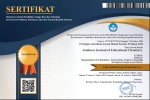Evaluating Differentiated Chemistry Instruction in Senior High Schools Using Stake’s Countenance Model: A Study in Gorontalo City
Abstract
Keywords
Full Text:
PDFReferences
Anderson, L. W., & Krathwohl, D. R. (2001). A taxonomy for learning, teaching, and assessing: A revision of Bloom’s taxonomy of educational objectives. Longman.
Braun, V., & Clarke, V. (2006). Using thematic analysis in psychology. Qualitative Research in Psychology, 3(2), 77–101. https://doi.org/10.1191/1478088706qp063oa
Creswell, J. W., & Creswell, J. D. (2018). Research design: Qualitative, quantitative, and mixed methods approaches (5th ed.). SAGE Publications.
Dinas Pendidikan dan Kebudayaan Provinsi Gorontalo. (2024). Data Sebaran SMA Kota Gorontalo Tahun 2024. Gorontalo: Dinas Pendidikan.
Fitriyah, N., & Bisri, M. (2023). Hubungan guru dan siswa dalam pembelajaran berdiferensiasi. Jurnal Ilmu Pendidikan, 17(2), 122–135. https://doi.org/10.1234/jip.v17i2.2023
Hartini, S., Usman, H., & Prafitasari, H. (2023). Minat belajar siswa melalui pembelajaran berdiferensiasi. Jurnal Pendidikan Sains Indonesia, 11(3), 44–57. https://doi.org/10.1234/jpsi.v11i3.2023
Hockett, J. A. (2009). Differentiation in practice: A resource guide for differentiating curriculum, grades 5–9. ASCD.
Kementerian Pendidikan, Kebudayaan, Riset, dan Teknologi. (2022). Permendikbudristek No. 16 Tahun 2022 tentang Standar Proses Pendidikan. Jakarta: Kemdikbudristek.
Kementerian Pendidikan, Kebudayaan, Riset, dan Teknologi. (2022). Permendikbudristek No. 21 Tahun 2022 tentang Standar Penilaian Pendidikan. Jakarta: Kemdikbudristek.
Kementerian Pendidikan, Kebudayaan, Riset, dan Teknologi. (2024). Panduan Pembelajaran dan Asesmen Edisi Revisi 2024. Badan Standar, Kurikulum, dan Asesmen Pendidikan (BSKAP).
Kementerian Pendidikan, Kebudayaan, Riset, dan Teknologi. (2024). Panduan pembelajaran dan asesmen edisi revisi tahun 2024. Badan Standar, Kurikulum, dan Asesmen Pendidikan (BSKAP). https://kurikulum.kemdikbud.go.id
Lukum, A. (2015). Model Evaluasi Pembelajaran Kimia SMA. UNG Press.
Mairoza, D., Roza, W., & Samanhudi, U. (2024). An english teachers’ perspectives on differentiated instruction in ‘kurikulum merdeka’: a case study in sma kabupaten solok. Lectura Jurnal Pendidikan, 15(1), 207-221. https://doi.org/10.31849/lectura.v15i1.18276
Stake, R. E. (1967). The countenance of educational evaluation. Teachers College Record, 68(7), 523–540.
Stufflebeam, D. L., & Shinkfield, A. J. (2007). Evaluation theory, models, and applications. Jossey-Bass.
Stradling, R. (2005). Differentiation in education. In A. Hargreaves (Ed.), The education of teachers: International perspectives (pp. 71–84). Open University Press.
Subban, P. (2006). Differentiated instruction: A research basis. International Education Journal, 7(7), 935–947. http://iej.cjb.net
Tomlinson, C. A. (2014). The differentiated classroom: Responding to the needs of all learners (2nd ed.). ASCD.
Wicaksono, R. (2024). Penerapan pembelajaran berdiferensiasi untuk meningkatkan prestasi belajar siswa. Jurnal Inovasi Pembelajaran Kimia, 8(1), 50–62. https://doi.org/10.1234/jipk.v8i1.2024
Worthen, B. R., Sanders, J. R., & Fitzpatrick, J. L. (1997). Program evaluation: Alternative approaches and practical guidelines. Longman.
DOI: https://doi.org/10.37905/jjec.v7i1.31729
Refbacks
- There are currently no refbacks.
Editorial Office

|
Department of Chemistry, Universitas Negeri Gorontalo |

|
E-mail: [email protected] |

|
|

|
Jambura Journal of Educational Chemistry (p-ISSN: 2655-7606 | e-ISSN: 2656-6427) by Department of Chemistry Universitas Negeri Gorontalo. This work is licensed under a Creative Commons Attribution 4.0 International License. Powered by Public Knowledge Project OJS |










